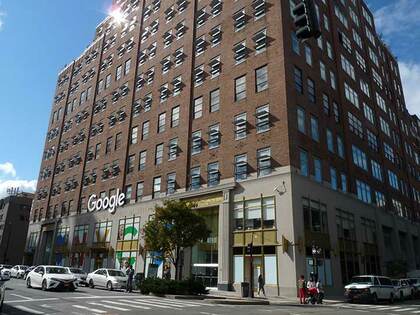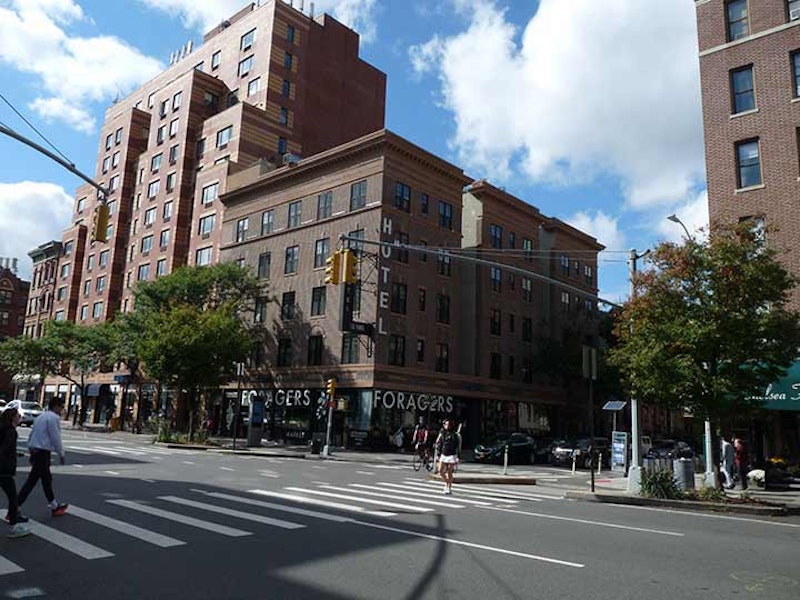I worked in the vicinity of Chelsea from 1988-1992 and again from 2000-2004 in a variety of positions at small type shops, defunct trade schools and at Macy’s, which turned out to be the least favorite job in the era; the other work was in Cyrillic and a number of my teammates only spoke Russian. The shop had the Circus account: by then the magazine was covering pop metal, so I’d be looking over the adventures of Bret Michaels and Axl Rose while finding out who’s “ringing up” a birthday in the Lou O’Neill columns. I was able to get out and walk around at lunch hours, and often set out south on 8th Ave..

I haven’t been in the Hotel Vigilant, #370 8th Ave. between W. 28th and W. 29th. It’s a reminder of the old Bowery over on the east side, before it was transmogrified and be-glitzed as the magic wand of development tuned it into a boulevard of high-rises and restaurants. The subways, for all their improvement, are still hellish on occasion, and it has to do with a way of thinking by those in charge: “You take the subways for a reason, and you take limos for another reason.” If you’re down, you must deserve to be.
The Vigilant is a survivor of a mini-hotel row on 8th Ave. in the nebulous area south of Penn Station (built in 1910) and north of Chelsea. The Hotel Vigilant was apparently built in 1916 and by 1932, rooms were offered for 32¢ a night. By 2012 the price was up to $40, or $140 per week. Only men are permitted lodgings.
The Vigilant is a fleabag in the truest sense of the word, and could also be called a bedbug-bag, as the bloodsucking arthropoda crawl all over the five-story Italianate brick building. However, in an amenity few hostels provide, nontoxic bug spray is available. Rest rooms and showers are shared, and smoking is permitted in the rooms, which are 8x8x4 feet and are divided from other rooms by slight wooden slats. There’s one lamp per “cubicle,” a wooden plank for a shelf, and an electric outlet.

Fashion Institute of Technology (FIT) was founded in 1944, associated with the State University of New York, offering a four-year graduate program with emphasis on the fashion industry; it’s located between W. 26th and 28th between 7th and 8th Aves., toward the south end of NYC’s Garment District. The Brutalist-style buildings [De Young & Moscowitz arch.], constructed in 1977, consist of the Fred Pomeranz Art and Design Center, David Dubinsky Student Center (shown here), a dormitory center named for ILGWU leader who helped found the American Labor Party and New York’s Liberal Party, and the Center for Design Innovation. The Museum at FIT is open to the public.
I chiefly remember FIT since one a week, on a lunch break from ANY Phototype on W. 29th St. between 1988-1991, I’d eat at a pizzeria across from the Dubinsky building and hang around afterward and girl-watch. I was in my 20s.

I passed by this building at 8th Ave. and 23rd St hundreds of times, as millions have, and plenty of times caught sight of the name “John Q Aymar” on the 8th Ave. side. I looked him up, and it continues to be a puzzle. The Aymars were a family of merchant princes in gaslight New York from the 1820s to the Civil War era, and more than one member was called John Q. Aymar. One of the JQAs is buried in Green-Wood Cemetery, and the Metropolitan Museum of Art owns a portrait of one of the JQA families painted in 1838.
According to an item in The New York Times of August 8th 1937, the building was named for John Q. Aymar, great-grandfather of Bradish G. and Aymar Johnson, trustees of the Aymar Johnson estate, who developed the property that John Q. had purchased back in 1839. The Q stood for Quereau. The building was torn down last year.

I despaired momentarily when I saw the rollgate shuttered at the Trailer Park Lounge on W. 23rd just east of 8th, but I was here before it opened. If you haven’t, the interior, seen here on its website, has to be seen to be believed because it’s chockablock with memorabilia from most decades of the 20th century. The menu is all rich fried food. I was introduced to the place a few years ago at the after-party for the annual Guides Association of New York Awards show (I won Best Website, the first ever awarded, in 2015). A lot of people attend in tuxedos and gowns and there they were in the Trailer Park Lounge, which kept the margaritas and onion rings coming.
A couple of doors down on W. 23rd, I went Midnight Records, which specialized in the 1960s-era garage punk records which remain my favorite genre to this day. Midnight closed about 20 years ago but retained a mail order business for a number of years. I once staggered into another used record place on Mercer St. and was mistaken for Jack Casady of Jefferson Airplane.

Probably the most famous image of Albert Einstein is Einstein playfully sticking his tongue out, photographed by Arthur Sasse in 1951. The image appears on the side of 212 8th Ave. at W. 21st, home to the Vibe lingerie store on the ground floor, formerly the Rawhide club. This is an early Eduardo Kobra, perhaps the finest muralist working in NYC today.

At 8th Ave. and W. 19th is the Joyce Theatre, a 472-seat dance performance venue opened in 1982 in the renovated and remodeled Elgin Theatre that had come on hard times in the 1970s as a porno palace—the renovation was supervised by architect Hugh Hardy, whose work can be seen all over town. I’m not a ballet or modern dance fan, but I mention the theater because it’s named for one of the founders of one of my workplaces. Joyce Mertz-Gilmore along with her parents, Harold and LuEsther Mertz, founded Publishers Clearing House, the premier direct marketing company in the country, in their basement in Sands Point, NY, in 1953. The Joyce Theatre exists in great part due to the philanthropic efforts of LuEsther Mertz.

Though this particular section of Chelsea isn’t landmarked, these two buildings at #145 and 147 near W. 17th are. This section of Chelsea, in the post-colonial era, was owned by George Rapelje, who operated a farm. The Clement Clarke Moore holdings were just to the north and the most obvious relic of that time is the General Theological Seminary of the Episcopal Church grounds between 9th and 10th Aves. at W. 20th St.
8th Ave. was built in Chelsea in 1816, just five years after the “Commissioners’ Plan” for the Manhattan street grid was enacted and about a decade after John Randel surveyed the area on horseback. It took nearly a decade but Rapelje finally sold the property in the mid-1820s, with these two houses developed by Steven Weeks and Aaron Dexter in 1827 and 1828. From 1850-1870 #145 was the site of a popular photo studio.

111 8th Ave. is one of the few NYC buildings that takes up an entire square block: between 8th and 9th Aves. and W. 15th and 16th Sts. It’s an Art Moderne classic constructed in 1932 and designed by Lusby Simpson of Abbott, Merkt & Co. as the Port Authority Commerce Building. It was a multi-use building designed to be used as a trucking terminal and also to handle exhibitions and manufacturing.
At its peak in the 1930s the Port Authority serviced 8000 tons of goods in the building and as many as 650 trucks passed into the building daily. The building has 15 floors the size of football fields.
As less shipping took place on the Manhattan side of the Hudson the building wasn’t as important, but it did serve as Port Authority headquarters from 1947 to 1980. For about a decade beginning in 1998 Taconic Investment Partners owned the building and used it as a data center during the internet boom. In 2010 the building was acquired by Google, which installed large white logos on the 8th and 9th Ave. sides. However, Art Deco details in gold finish at the building’s entrances have remained intact.

This copper domed, Corinthian-columned building on the NW corner of 8th Ave. and W. 14th St. is the former New York Bank For Savings, constructed in 1897 by architect Robert Henderson Robertson. It passed through incarnations as Goldome Bank, Central Carpet, Balducci’s, and the fanciest CVS drugstore in NYC. The Classic Revival bank resembles its contemporary, the Bowery Savings Bank in Chinatown. The former bank was restored in the 1980s by Robert Scarano Jr. Note the white marble exterior and the stained glass windows surrounding the dome. The copper clock features renderings of bees and beehives, a traditional symbol of thrift.

Located on the triangle between 8th and Greenwich Aves. and Horatio St., Jackson Sq. has officially been a public park since 1872, though it appears as a “square” on maps prior to that. It’s thought that the square is named for its most obvious honoree, President Andrew Jackson ( 1767-1845) since AJ was a hero in Tammany Hall circles. However, Mozart Hall, a faction that had split off from Tammany, met in a building called Jackson Hall at #2 Horatio across the street from the park. Mozart Hall founder and pro-Confederate Fernando Wood was elected mayor of NYC in 1854 and served three non-consecutive terms. The large iron fountain was added as part of renovations that took place in 1990.
Kevin Walsh is the webmaster of the award-winning website Forgotten NY, and the author of the books Forgotten New York (HarperCollins, 2006) and also, with the Greater Astoria Historical Society, Forgotten Queens (Arcadia, 2013)

